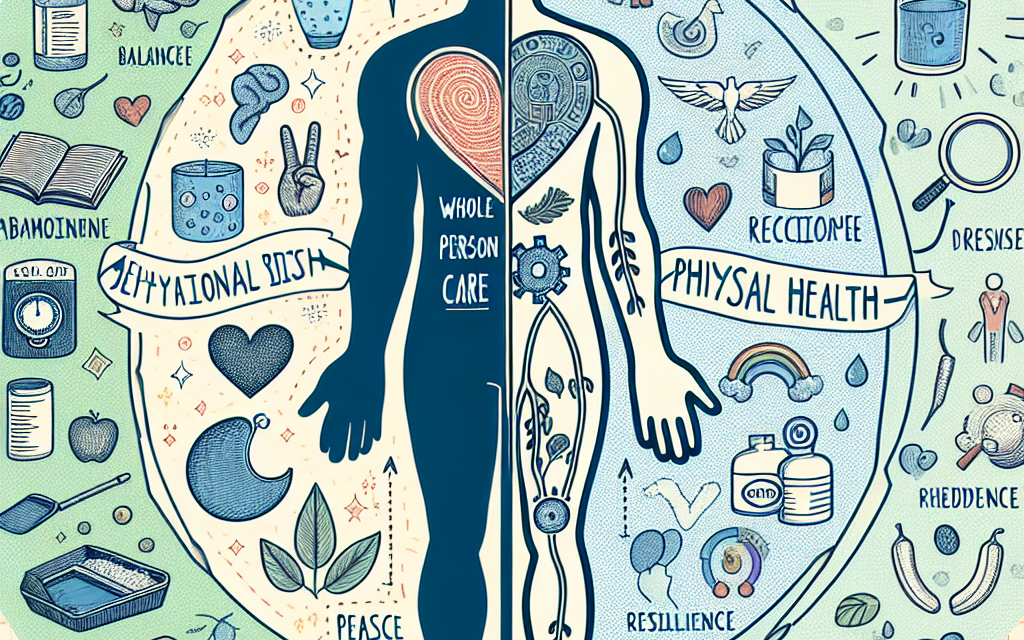Understanding the Connection Between Behavioral and Physical Health: The Importance of Whole-Person Care
In recent years, the healthcare landscape has increasingly recognized the intricate relationship between behavioral and physical health. This understanding has led to the emergence of whole-person care, a holistic approach that addresses the complete spectrum of an individual’s health needs. This article delves into the connection between behavioral and physical health, exploring the importance of whole-person care through five key subtopics: the interrelationship of mental and physical health, the impact of social determinants, the role of integrated care models, the significance of preventive measures, and the future of whole-person care.
The Interrelationship of Mental and Physical Health
The connection between mental and physical health is well-documented, with numerous studies highlighting how psychological well-being can significantly influence physical health outcomes. Conversely, chronic physical conditions can lead to mental health issues, creating a cyclical relationship that can be challenging to break.
Research indicates that individuals with mental health disorders are at a higher risk for developing chronic physical conditions. For instance, a study published in the journal Psychosomatic Medicine found that individuals with depression are 40% more likely to develop cardiovascular disease. Similarly, anxiety disorders have been linked to a higher incidence of gastrointestinal issues, such as irritable bowel syndrome (IBS).
On the other hand, chronic physical illnesses can exacerbate mental health problems. For example, a person diagnosed with diabetes may experience feelings of anxiety or depression due to the stress of managing their condition. The American Diabetes Association reports that nearly 1 in 3 adults with diabetes also experience depression, which can hinder their ability to manage their health effectively.
Understanding this interrelationship is crucial for healthcare providers. By recognizing that mental and physical health are intertwined, providers can develop more effective treatment plans that address both aspects of a patient’s well-being. This approach not only improves health outcomes but also enhances the overall quality of life for patients.
The Impact of Social Determinants on Health
Social determinants of health (SDOH) are the conditions in which people are born, grow, live, work, and age. These factors significantly influence both behavioral and physical health outcomes. Key social determinants include socioeconomic status, education, neighborhood and physical environment, employment, and social support networks.
For instance, individuals living in low-income neighborhoods may have limited access to healthcare services, nutritious food, and safe environments for physical activity. This lack of access can lead to higher rates of obesity, diabetes, and other chronic conditions. A report from the World Health Organization (WHO) highlights that people in lower socioeconomic groups are more likely to experience poor health outcomes due to these social determinants.
Moreover, education plays a critical role in health literacy, which affects an individual’s ability to make informed health decisions. A study published in the American Journal of Public Health found that individuals with lower educational attainment are more likely to engage in unhealthy behaviors, such as smoking and physical inactivity, which can lead to adverse health outcomes.
Addressing social determinants is essential for achieving whole-person care. Healthcare providers must consider these factors when developing treatment plans and interventions. For example, community health programs that provide education, resources, and support can help mitigate the impact of social determinants on health. By fostering a supportive environment, healthcare providers can empower individuals to take control of their health and well-being.
The Role of Integrated Care Models
Integrated care models are designed to provide coordinated and comprehensive care that addresses both behavioral and physical health needs. These models emphasize collaboration among healthcare providers, including primary care physicians, mental health professionals, and social workers, to create a seamless care experience for patients.
One successful example of an integrated care model is the Collaborative Care Model (CCM), which has been implemented in various healthcare settings. The CCM involves a team-based approach where primary care providers work alongside behavioral health specialists to manage patients with mental health conditions. Research has shown that this model can lead to significant improvements in both mental and physical health outcomes.
A study published in the Journal of the American Medical Association found that patients receiving care through the CCM experienced a 50% reduction in depressive symptoms compared to those receiving usual care. Additionally, patients in integrated care settings reported higher satisfaction with their healthcare experience.
Integrated care models also facilitate early intervention and preventive care, which are crucial for addressing health issues before they escalate. By providing comprehensive assessments and ongoing support, healthcare teams can identify potential health risks and implement strategies to mitigate them. This proactive approach not only improves individual health outcomes but also reduces healthcare costs by preventing the need for more intensive interventions.
The Significance of Preventive Measures
Preventive measures play a vital role in promoting whole-person care by addressing health issues before they develop into more serious conditions. Preventive care encompasses a range of services, including screenings, vaccinations, and lifestyle counseling, aimed at reducing the risk of chronic diseases and improving overall health.
Research has shown that preventive measures can significantly impact both physical and behavioral health. For example, regular screenings for conditions such as hypertension and diabetes can lead to early detection and management, reducing the risk of complications. The Centers for Disease Control and Prevention (CDC) estimates that effective preventive care could save the U.S. healthcare system billions of dollars annually by reducing the incidence of chronic diseases.
Moreover, preventive measures that focus on mental health are equally important. Programs that promote mental well-being, such as stress management workshops and community support groups, can help individuals develop coping strategies and resilience. A study published in the Journal of Mental Health found that individuals who participated in preventive mental health programs reported lower levels of anxiety and depression.
Incorporating preventive measures into whole-person care requires a shift in the healthcare paradigm. Providers must prioritize preventive services and educate patients about the importance of maintaining both physical and mental health. By fostering a culture of prevention, healthcare systems can empower individuals to take charge of their health and reduce the burden of chronic diseases.
The Future of Whole-Person Care
The future of whole-person care is promising, with ongoing advancements in technology, policy, and research paving the way for more integrated and comprehensive healthcare solutions. As the healthcare landscape continues to evolve, several trends are emerging that will shape the future of whole-person care.
- Telehealth and Digital Health Solutions: The rise of telehealth has transformed the way healthcare is delivered, making it more accessible for individuals seeking both physical and mental health services. Digital health solutions, such as mobile apps and online therapy platforms, are also gaining popularity, allowing patients to engage with their healthcare providers from the comfort of their homes.
- Value-Based Care: The shift towards value-based care emphasizes the importance of patient outcomes rather than the volume of services provided. This model encourages healthcare providers to focus on delivering high-quality, coordinated care that addresses the whole person, ultimately leading to better health outcomes.
- Policy Changes: Policymakers are increasingly recognizing the importance of whole-person care and are implementing initiatives to promote integrated care models. For example, the Affordable Care Act has provisions that support mental health parity, ensuring that mental health services are covered on par with physical health services.
- Community Engagement: Engaging communities in health initiatives is crucial for promoting whole-person care. Community-based programs that address social determinants of health can empower individuals to take control of their health and well-being.
- Research and Innovation: Ongoing research into the connection between behavioral and physical health will continue to inform best practices in whole-person care. Innovations in treatment approaches, such as personalized medicine and behavioral interventions, will enhance the effectiveness of care delivery.
As we look to the future, it is essential for healthcare providers, policymakers, and communities to work collaboratively to promote whole-person care. By addressing the interconnectedness of behavioral and physical health, we can create a more effective and compassionate healthcare system that prioritizes the well-being of individuals.
Conclusion
Understanding the connection between behavioral and physical health is crucial for developing effective healthcare strategies that address the whole person. The interrelationship between mental and physical health, the impact of social determinants, the role of integrated care models, the significance of preventive measures, and the future of whole-person care all highlight the need for a comprehensive approach to health and well-being.
By embracing whole-person care, healthcare providers can improve health outcomes, enhance patient satisfaction, and reduce healthcare costs. As we continue to advance our understanding of the complex interplay between behavioral and physical health, it is imperative that we prioritize integrated care solutions that empower individuals to lead healthier, more fulfilling lives.





